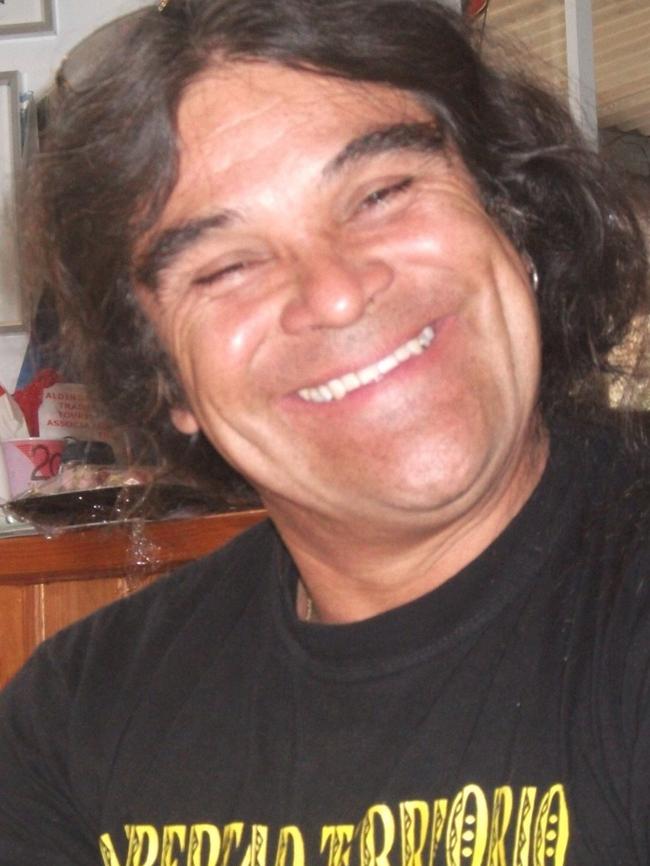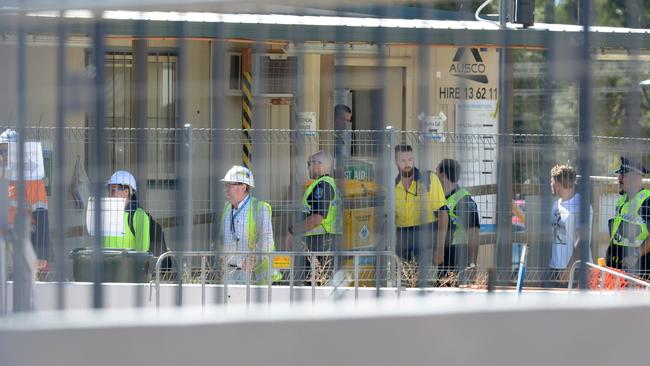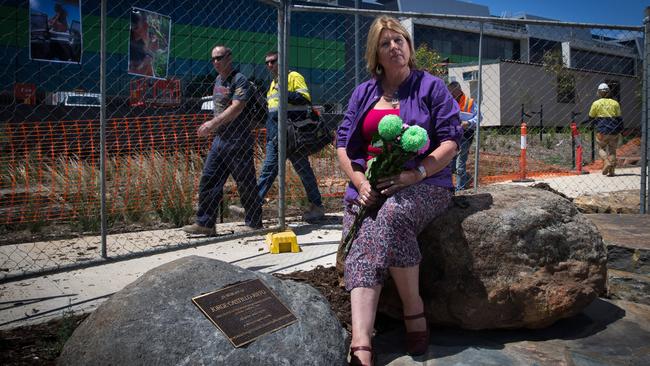Steve Wyatt becomes second man killed on new Royal Adelaide Hospital construction site
WORKERS have walked off the new RAH site until tomorrow, following the death on Saturday of a grandfather remembered as a doting family man.
SA News
Don't miss out on the headlines from SA News. Followed categories will be added to My News.
- TRAGIC: Second man killed on new RAH worksite
- NEW LAW: Sterner punishment bid for fatal workplace negligence
- FIRST DEATH: Partner wants justice for worker killed at RAH site
- DELAYS: Race against time to have hospital ready by November
- $100 MILLION: Claims empty hospital will cost a fortune
WORKERS have voted to walk off the new RAH site until tomorrow, following the death of a grandfather in an industrial accident.
Father-of-two Stephen “Steve” Wyatt, 63, died after being crushed between a scissor lift and the head of a low doorway while supervising the fitout inside the CBD site on Saturday afternoon.
His family has led tributes to the highly respected electrical engineer, who had 42 years’ experience across the building industry, as multiple investigations continued.
Their emotional tribute came as hundreds of workers attended a mass meeting early today amid mounting safety concerns and time pressures over the project plagued by delays.
In the 7am meeting, workers voted to walk off the site and return on Tuesday.
Mr Wyatt’s death was the second fatality involving scissor lifts at the new RAH site.
Jorge Castillo-Riffo, 54, was also working on a scissor lift at the site when he was crushed against concrete and sustained fatal head and neck injuries on November 27, 2014.
After his death, new guidelines were introduced that mandated two people use the lifts to avoid future fatalities.
The latest incident has triggered renewed calls for a coronial inquest into the deaths and safety standards at the new RAH site .
Workers said they would not be working today out of respect for Mr Wyatt.
One worker said the mood was “a bit down” on site this morning.
“When someone gets killed, it’s never good is it,” he said.
He said working on the site otherwise was “pretty good”.
Another worker, who asked not to be named, said workers would spend today reflecting on the tragedy.
“It’s a day that we go home and just reflect on what happened and out of respect for our fellow worker,” he said.
“It was a very sombre mood, everyone’s out to help each other and look after each other.
“We come back tomorrow.”
He said workers were told at the meeting that scissor lifts would be taken off the site because they were no longer needed.
“They’re not needed any more. No reason (for them). Just find other measures of finishing what has to be done.”
Mr Wyatt’s family told The Advertiser how the “great bloke”, affectionately known as “Slippery”, had been the “happiest” in life after recently becoming self-employed.
He doted on his three grandchildren, aged 17, 11 and nine, was a passionate Power supporter and had “loved” his supervisory role on the new RAH site for the past 18 months.

His grieving wife of 42 years, Deb, is being comforted by relatives, including their adult children, aged 35 and 32, at their Wynn Vale home, in Adelaide’s northern suburbs.
CFMEU state secretary Aaron Cartledge said Monday morning’s short meeting paid respect to Mr Wyatt, and made counsellors available to workers.
“A decision was made that there would be no work today and tomorrow morning we would start picking up the pieces.
“We also discussed that there would be no work with scissor lifts on this site until further notice.”
Many building industry workers at the site had known Mr Wyatt for 25 years.
“Workers really feel this because they put themselves in those positions, or they think about what their families would do if it was them and it really hits home to them.”
Workers will return to the site on Tuesday morning, when safety briefings would first be held before workers picked up their tools.
“They will start working through their job safety analysis and going through what activities they have to do with scissor lifts and what other (equipment) they can use instead.
“Basically a slow start to production.”
Mr Cartledge said there would have to be “an absolute need” for scissor lifts to be used on the site again.
“There is other plant equipment that can be used such as mobile scaffolds or chariot ladders so we will be assessing whether they absolutely need a scissor lift or whether they can do it with other equipment for the time being,” he said.

“We need to really have a look at these incidents and come up with recommendations on our use of these equipment — is it training, is it fatigue, is it experience, are there devices that can be put on this equipment to make them safer?
“We’ve been pushing very hard for proximity sensors, they are quite common in Europe on these machines, particularly around Jorge (Castillo-Riffo’s) death 15 months ago, they likely could have saved his life.”
Mr Cartledge said workers were extremely upset by Mr Wyatt’s death.
“I had phone calls over the weekend from that first response team when Jorge died, and they’re not in a good way. It brings back those memories,” he said.
“There’s a lot of workers doing it hard at the moment.”
Mr Cartledge was critical of the pressure placed on workers by project deadlines.
“If the State Government is not going to take possession of the hospital on the deadline, then we should extend the deadline.
“I’m not saying that the schedule and that pressure had anything to do with this accident, but I’m certainly not writing it off either that will all come out in the investigation.”


In a statement, his family described how Mr Wyatt, an experienced consultant with Hansen Yunken Leighton Contractors Joint Venture, had a zest for life.
“He was a very loving husband, devoted father and doting grandfather,” they said. “He was very respected in the building industry as an electrical engineer for 42 years.
“Now self-employed and working as a subcontractor on the RAH site … as recently as last Wednesday he said it was the happiest he has ever been.”
Mrs Wyatt told The Advertiser how the pair had travelled around Australia, starting with his first job in Darwin, where he helped rebuild the city after Cyclone Tracy in 1974.
They also lived in Canberra before returning to Adelaide in the early 1980s. “He was so lovely, a very sweet man and very calm,” she said.
“He was a lovely person and he is going to be missed by all who knew him. Some people say he was enjoying the best times of his life and it is ironic he is not going to enjoy it now.”


Authorities were called to the scene at 3.05pm on Saturday, where Mr Wyatt died from head injuries.
It is understood Mr Wyatt and the lift’s “devastated” driver had travelled underneath the doorway several times during the afternoon. The driver is receiving counselling.
On Sunday, senior project management held crisis meetings on the site for several hours. In a joint statement, HYLC and SA Health Partnership said support was offered to the workforce “during this extremely difficult time”.
Health Minister Jack Snelling was also “very, very saddened by this shocking accident”.
“When I first heard the news ... there was certainly disbelief on my part that you could have two fatal accidents ... both involving similar equipment,” he said.
He said it was “too early” to discuss coronial inquests.
SafeWork SA is heading the investigation and police are also preparing a report for the coroner.
— with Lauren Novak and Jill Pengelley
Timeline of a troubled site
OCTOBER 25, 2013: A crane carrying a pile of heavy timber suddenly accelerates as it lowers its load, causing up to 50 sheets of wood to fall more than 2m. No one is injured, minor damage is caused. Safework SA launches an investigation.
JUNE 9, 2014: The builders of the new RAH confirm they are bringing on hundreds more workers and increasing spending to ensure the hospital opens on time. Contractors are working in two shifts covering about 18 hours a day, six days a week.
JUNE 19, 2014: Another crane malfunctions, dropping a load of steel near workers. Nobody is injured.
AUGUST 21, 2014: Another crane collides with a concrete pumping boom, causing minor damage but no one is injured. Workers walk off the job and Safework SA inspects the site. At the time, it is the 13th notifiable incident involving the eight cranes on site since 2013.
NOVEMBER 28, 2014: Construction worker Jorge Castillo-Riffo, 54, dies in hospital after suffering crush injuries the previous day while he was using a scissor lifter on the new RAH site. Work is suspended until December 2.
DECEMBER 22, 2014: Health Minister Jack Snelling reveals the new RAH will likely not be completed until the second half of 2016.
MARCH 17, 2015: The Advertiser reveals Andrew Nielsen, the man hired to oversee the move to the new site, has quit abruptly for “personal reasons”, just eight months after he was appointed.
APRIL 8, 2015: It is revealed the $422 million electronic system, designed for “paperless” hospitals, will not be rolled out at the existing RAH as promised, casting doubt over whether it will be ready when the new hospital opens.
FEBRUARY 1, 2016: Mr Snelling reveals the technical completion date for the new hospital, set for early April, is likely to be pushed back by up to two months.
FEBRUARY 15, 2016: A parliamentary committee hears the Government will pay up to $100 million to run an empty new RAH for months because of a Government decision not to open the hospital in the winter flu season.
FEBRUARY 20, 2016: Stephen “Steve” Wyatt, 63, dies after being crushed between a scissor lift and the head of a low doorway while supervising the fitout inside the site.


